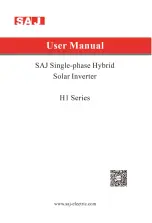
1–1
T-360
SECTION 1
SAFETY SUMMARY
1.1
GENERAL SAFETY NOTICES
Installation and servicing of Genset equipment can be hazardous due to system belts, radiator fan, and electrical
components. Only trained and qualified service personnel should install, repair, or service Genset equipment.
When working on Genset equipment, observe all potential Danger, Warning and Caution hazards, including those
shown below and on hazard labels attached to the unit.
The following general safety notices supplement specific warnings and cautions appearing elsewhere in this man-
ual. They are recommended precautions that must be understood and applied during operation and maintenance
of the equipment covered herein. The general safety notices are presented in the following three sections labeled:
First Aid, Operating Precautions and Maintenance Precautions. A listing of the specific warnings and cautions
appearing elsewhere in the manual follows the general safety notices.
1.2
FIRST AID
An injury, no matter how slight, should never go unattended. Always obtain first aid or medical attention immedi-
ately.
1.3
OPERATING PRECAUTIONS
Always wear safety glasses and hearing protection.
Keep hands, clothing and tools clear of the radiator fan and rotating belts.
Wear appropriate personal protective equipment for the work being undertaken.
No work should be performed on the unit until all circuit breakers and start-stop switches are turned off and the
negative battery terminal has been disconnected.
Always work in pairs. Never work on the equipment alone.
In case of severe vibration or unusual noise, stop the unit and investigate.
1.4
MAINTENANCE PRECAUTIONS
Be sure power is turned off and the negative battery cable is disconnected before working on generator set.
Do not bypass any electrical safety devices, e.g. bridging an overload, or using any sort of jumper wires. Problems
with the system should be diagnosed, and any necessary repairs performed, by qualified service personnel.
In case of electrical fire, open circuit switch and extinguish with CO
2
(never use water).
Fuel Tanks present explosion, fire, and rupture hazards even if liquid fuel has been drained. Do not attempt any
repairs, especially repairs using flame, welder or torch, unless you have been properly trained and the tank has
been emptied of liquid fuel and fuel vapors and the tank is properly ventilated.
1.5
UNIT HAZARD LABEL IDENTIFICATION
To help identify the hazard labels on the Unit and explain the level of awareness each one carries, explanations
with appropriate consequences are provided below:
DANGER
!
Indicates an immediate hazard which WILL result in severe personal injury or death.
WARNING
!
Indicates hazards or unsafe conditions which COULD result in severe personal injury or death.
CAUTION
!
Indicates potential hazards or unsafe practices which COULD result in minor personal injury,
product, or property damage.
Содержание Carrier Transicold 69UG15
Страница 2: ......
Страница 4: ......
Страница 12: ......
Страница 36: ......
Страница 64: ......
Страница 66: ...T 360 6 2 Figure 6 2 Schematic Diagram PIDs prior to UG2019 62 11725 0...
Страница 67: ...6 3 T 360 Figure 6 3 Schematic High Voltage Circuitry PIDs prior to UG2019...
Страница 68: ...T 360 6 4 Figure 6 4 Schematic Diagram Legend PIDs UG2019 and Up 62 04233 00...
Страница 69: ...6 5 T 360 Figure 6 5 Schematic Diagram PIDs UG2019 and Up 62 04233 00...
Страница 70: ...T 360 6 6 Figure 6 6 Schematic High Voltage Circuitry 7 Wire Generator PID UG2019 62 04232 00...
Страница 71: ...6 7 T 360 Figure 6 7 Schematic High Voltage Circuitry 8 Wire Generator PIDs UG2020 and Up 62 04235 00...
Страница 72: ...T 360 6 8...
Страница 75: ......










































